
NASA may soon make investigating Uranus, the seventh planet from the Sun in our solar system, a priority as scientists know very little about the ice giant that is considered one of the most common types in our galaxy.
Uranus is perhaps the strangest planet in our solar system as at some point during its history it was knocked over. This caused it to spin on its side with more than a dozen rings circling around it and 27 moons clinging close to it.
Investigating Uranus
Furthermore, the planet's atmosphere is a collection of hydrogen, helium, and heavier compounds that exist as ices found deep in the frigid Uranian clouds. However, beyond the basic or intriguing facts that we know of, experts have very little information regarding the ice giant.
There was only one time that a human-made spacecraft visited Uranus, which was in 1986 with the help of Voyager 2. But a recent report prepared by planetary scientists and released this week has urged the space agency to make a mission to Uranus a top priority in the coming decade, as per National Geographic.
The scientists in charge of the report detailing the recommendation used a process called the decadal survey. It was led by the National Academy of Sciences and offered NASA guidance for prioritizing scientific goals.
Read Also: New Study Suggests Ancient Pterosaurs Had Feathers That Change Colors at a Cellular Level
The report highlighted a mission concept that they called the Uranus Orbiter and Probe (UOP) for a multi-year orbital tour. They said that during that time it should jettison an atmospheric probe. The committee that sent the report said that Uranus is "one of the most intriguing bodies in the solar system."
According to Space, they targeted launch opportunities in the early 2030s that would go on a 12 to 13-year cruise to make observations of Uranus. A planetary scientist at the University of Leicester in the United Kingdom, Leigh Fletcher, who also participated in the decadal survey process, said that the prioritization is a wonderful leap for the outer solar system community.
Understanding the Solar System
NASA has broadly followed the recommendations of previous National Academies reports where the last planetary decadal survey that was published in 2011 included prioritizing rock collection on Mars and a Jupiter mission, specifically on its moon Europa.
The first of the two prioritizations led to the Perseverance rover which is now on the surface of the Red Planet and conducting its mission. The second is currently being prepared for launch and is scheduled for 2024 and is called the Europa Clipper spacecraft.
The recommendation comes as many of the planets that have been discovered in recent years are roughly three to four times the width of the Earth, which is similar to the size of Uranus. Fletcher added that the situation actually poses a problem for planet formation theories.
The scientist said that experts believe they understand how something gets to be as big as Jupiter and think that they understand how a planet gets to be the size of Earth and Venus. However, in between these sizes, there's what they call a "sweet spot" that many still don't fully understand, BBC reported.
Related Article:
Jupiter's Moon Europa Has Water in Earth-Like Ice Sheets That Gives Hint About Existing Alien Life
© 2025 HNGN, All rights reserved. Do not reproduce without permission.








